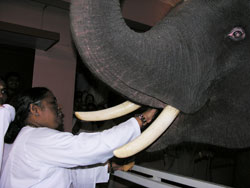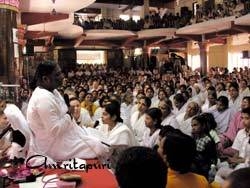1 March 2005, Amritapuri
One of the Ashram residents had read something in the paper and wanted to share it with Amma. So she placed the clipping in a pile of questions on Amma’s peetham during Tuesday’s Meditation Day.
It was the story of a group of elephants kept at a resort in Phuket, Thailand, that, 20 minutes before December’s tsunami, became so agitated that they broke free of their ground posts and ran up to the top of a hill.

Amma said that it is true that animals have many subtle senses. “Animals have many abilities that man does not have,” She said, citing as an example the ability of police dogs to track down criminals through their heightened sense of smell. “However, although they do have such abilities, they cannot do what humans can. We have never heard of a dog singing classical music or playing the tabala. For millions of years birds have been living in nests. They haven’t built multi-storied buildings. Nor have they made any atom bombs. But what man is not able to sniff and understand, a dog can.”
Amma explained that by systematically studying the behaviour of various animals, the Rishis of ancient India were able to establish and record systems for predicting future events. Among others, there are Gauli Shastra [the science of lizards], Shakuna Shastra [the science of birds], Nimitta Shastra [science of omens], Hastarekha Shastra [palmistry] and Jyotish [astrology].
Amma then told everyone how back when She was a girl, if crows were heard cawing in the morning in a certain peculiar way, housewives would take it as a sign: “They would be sure that guests would soon arrive and be sure to cook extra rice. And invariably some unexpected guest would come. These days housewives behave differently; if they were to know that a guest is coming they will get ready with an excuse! They may lock their doors and go out, or they may tell the guests, ‘You have chosen to come on the wrong day. Today is our day for fasting. Please share a cup of water with us.’”
Amma explained that these seemingly cryptic shastras show how through the observation of seemingly insignificant things we can infer wide-ranging implications. The idea being that all happenings in this world are interconnected, so much so that with reference to one we can ascertain the others.
“Different predictions are made according to the different movements made by house lizards,” Amma explained. “Suppose a lizard chirps in a particular place or moves in a particular direction—it will indicate some specific thing. Similarly, when a crow drops excreta on someone’s head at a particular time, it is taken as a sign that he will soon hear of the death of one of his relatives. Other birds indicate forthcoming good news.”
Amma continued to list some of the observations detailed in these shastras. A succession of dogs howling in a certain way is taken as a sign that a death will soon occur in the village. A black cat crossing one’s path is seen as an ill omen, and one typically will return home and wait some time before recommencing their journey. And if one’s vehicle strikes a pig, they will most likely sell it off, as the collision indicates that the vehicle could soon be involved in a more serious accident.
“Though all these may sound irrational, many people believe strongly in such things, as in their own experience they have come true,” Amma said. “Such sciences came as the result of years of research by the Rishis, so Amma doesn’t think that these are blind beliefs. Every country has their own beliefs, in their own different ways.”
Amma went on to explain how these ancient sciences are in truth not very different from the so-called traditional sciences, as both types of sciences considered an inference legitimate only after it passes an acceptable success rate. “Suppose a doctor tests a patient’s blood sample and finds that the white-blood-cell count is very high; he will consider it as a symptom of cancer,” Amma said. “If the count is too low, the doctor may consider it a sign of tuberculosis. When the doctor makes such predictions, it is not mere superstition. Suppose, a botanist tells us that a certain tree will flower after so many years or that a certain tree will bear fruit after so many years—again it is not mere superstition. Doctors and botanists are able to make such inferences as a result of their research. Similarly, when the ancient Seers established such systems, it was a result of their research.”

Amma went on to question why rationalists and modern scientists typically scoff at such ancient sciences like astrology: “The rationalists fail to understand that there is deep hidden meaning; the planets are symbols. Just as a national flag is not a mere flag but the symbol of an entire nation’s culture, heritage and pride, such planets carry deep hidden meaning. Depending on one’s time and place of birth and the position of the sun and other planets, astrological charts are made. It is subtle mathematics.”
Amma said that depending on the different phases of the moon, the heat and humidity in the earth’s atmosphere are affected. “It reflects not only in nature but also in us as well,” Amma said, citing as examples how on new and full moon days asthma intensifies, ladies experience heavier menstruation and mental patients suffer from insomnia. “We are closely related to nature.”
“Some people say, ‘Man has set foot on the moon and sent satellites to Mars, it is inert. How can it have an effect on humans?’ But the planets do have their effect.”
In case anyone was becoming a little too fascinated, Amma reminded the ashramites that we shouldn’t pay excessive attention to such things, that life is bound to bring pleasurable and painful situations and that the only way to remain unaffected by calamities is not by becoming a master of, say, palmistry, but by becoming a master of the mind.
“By doing spiritual practices such as meditation, we try to bring this pendulum of the mind into equilibrium,” Amma said. “Thus it is said that meditation is precious like gold. Swimming in the ocean is a nightmarish experience for someone who doesn’t know swimming, but for an expert swimmer it is very pleasant and joyful. The person who knows a firecracker is going to go off will not be shocked when he hears the explosion. On the other hand, one who doesn’t know will be shocked. Spirituality is the science that teaches us about the nature of the world and advises us how to live in it.”
Omens, jyotish, palmistry we can use such systems as means to warn us of times when it is important to be extra alert, but then we have to move forward with our lives using our God-given discrimination, Amma said. She then explained through a story how omens do not produce any results of their own, but merely point to results that have already been determined by some other factor.
“We must sharpen our discrimination,” Amma said. “Suppose we hear a warning that another tsunami is going to strike. All of us must run to a higher place. There is no point in waiting for the water to come.”
When all of creation is seen as but a bubble existing within one’s Infinite Self, the mysteries of the world unravel and their mechanics become as obvious as the back of one’s hand. To one with such a vision, the unfathomable latticework of creation is etched in every happening, on every grain of sand, on every creature great and small. Advanced mathematics, gravity, the heliocentric galaxy, the spherical earth, the elliptical universe, the concept of the atom, the macrocosm in the microcosm—these are but a few of the concepts investigated, discovered and recorded in the shastras of the Rishi-scientists millenniums ago. As Amma has said, “Nature is a book. It has to be studied.”
-Sakshi
